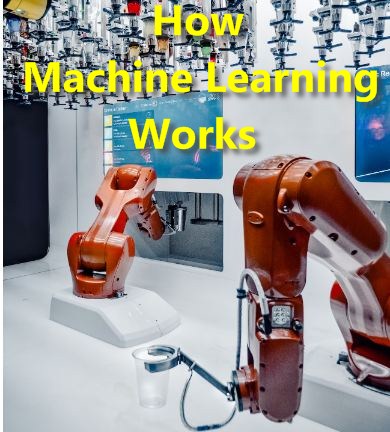How Machine Learning Works –
Machine learning works by teaching computers to make predictions or decisions based on data.

It involves several key steps:
- Data Collection: The first step is to gather data relevant to the problem you want to solve. This data can be in the form of text, numbers, images, or any other type of information. It should be representative of the real-world situation you’re interested in.
- Data Preprocessing: Before the data can be used for machine learning, it needs to be cleaned and prepared. This involves removing errors, handling missing values, and transforming data into a suitable format. For example, converting text into numerical values.
- Feature Engineering: Features are specific attributes or characteristics within the data that the machine learning algorithm uses to make predictions. Feature engineering involves selecting, creating, or transforming features to make the data more informative and relevant for the task.
- Model Selection: You choose a machine learning model that is suitable for your problem. There are various algorithms and models to choose from, each with its own strengths and weaknesses. Common models include decision trees, neural networks, support vector machines, and more.
- Training the Model: This is where the machine learning model learns from the data. The model is presented with the training data, and it adjusts its internal parameters to make accurate predictions. The model’s goal is to minimize the difference between its predictions and the actual data labels.
- Evaluation: After training, the model needs to be evaluated to determine how well it performs. This is typically done using a separate dataset (the test data) that the model hasn’t seen before. Common evaluation metrics include accuracy, precision, recall, and F1-score, depending on the type of problem.
- Fine-Tuning: If the model doesn’t perform well, you can fine-tune it by adjusting hyperparameters or reengineering features. This process may involve iterating through steps 4 to 6 multiple times until the desired performance is achieved.
- Deployment: Once you have a model that meets your performance requirements, you can deploy it for making predictions or decisions in real-world applications. This can be in the form of a mobile app, a web service, or an embedded system.
- Monitoring and Maintenance: Machine learning models may need regular monitoring to ensure they continue to perform well over time. Data drift or changes in the environment can impact a model’s accuracy, so updates and retraining may be necessary.
- Feedback Loop: You can incorporate feedback from the model’s predictions to continuously improve its performance. For example, in online recommendation systems, user interactions can provide feedback to refine recommendations.
In essence, machine learning is about training a model to learn patterns and relationships within data so that it can make predictions or take actions based on new, unseen data. The specific techniques and algorithms used can vary widely depending on the problem you’re trying to solve.
Example Of the Step By Step Machine Learning Process
let’s add an example to illustrate each step of how machine learning works:
1. Data Collection: Imagine you’re a librarian at a bookstore, and you want to predict which books are likely to be popular next year. You collect data on the books sold, customer reviews, and genres.
2. Data Preprocessing: You clean up the data by removing duplicate entries and fixing any typos or errors in book titles and customer reviews.
3. Feature Engineering: You create “features” such as the number of pages in each book, the average customer rating, and the genre of the book. These features help the computer understand the data better.
4. Model Selection: You choose a machine learning model, like a “Book Popularity Predictor,” that can analyze the data and make predictions about which books are likely to be popular.
5. Training the Model: You feed the model with historical data about book sales and reviews. The model learns from this data to understand which features (like book length or customer ratings) contribute to a book’s popularity.
6. Evaluation: You use a separate set of books from the past to see how well your model can predict which books were popular. You compare its predictions to the actual sales data.
7. Fine-Tuning: If the model doesn’t make accurate predictions, you adjust its settings, like giving more importance to customer ratings or considering additional features.
8. Deployment: Your “Book Popularity Predictor” is now ready to use. You can input data on new books, and it will predict which ones are likely to be bestsellers next year.
9. Monitoring and Maintenance: You regularly check the model’s predictions and update it as new sales and review data comes in. This ensures it stays up to date.
10. Feedback Loop: As reading habits change or new genres become popular, you adapt your model to include these changes. It’s like updating your bookstore’s offerings based on customer preferences.
In this example, the machine learning process helps you, the librarian, make data-driven predictions about book popularity, which can be crucial for stocking your bookstore with the right books for the coming year.
![]()